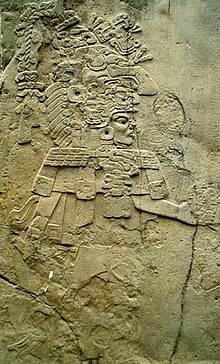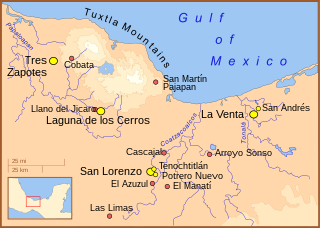
The Olmecs or Olmec were the earliest known major Mesoamerican civilization, flourishing in the modern-day Mexican states of Veracruz and Tabasco from roughly 1200 to 400 BCE during Mesoamerica's formative period. They were initially centered at the site of their development in San Lorenzo Tenochtitlán, but moved to La Venta in the 10th century BCE following the decline of San Lorenzo. The Olmecs disappeared mysteriously in the 4th century BCE, leaving the region sparsely populated until the 19th century.
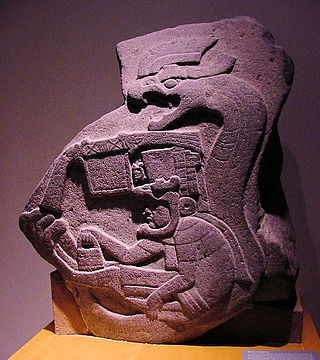
The religion of the Olmec people significantly influenced the social development and mythological world view of Mesoamerica. Scholars have seen echoes of Olmec supernatural in the subsequent religions and mythologies of nearly all later pre-Columbian era cultures.
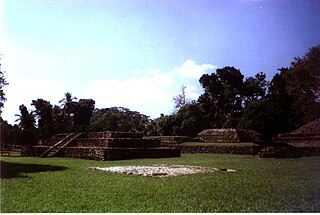
Izapa is a very large pre-Columbian archaeological site located in the Mexican state of Chiapas; it is best known for its occupation during the Late Formative period. The site is situated on the Izapa River, a tributary of the Suchiate River, near the base of the volcano Tacaná, the sixth tallest mountain in Mexico.

Tres Zapotes is a Mesoamerican archaeological site located in the south-central Gulf Lowlands of Mexico in the Papaloapan River plain. Tres Zapotes is sometimes referred to as the third major Olmec capital, but the Olmec phase is only a portion of the site's history, which continued through the Epi-Olmec and Classic Veracruz cultural periods.
Bloodletting was the ritualized practice of self-cutting or piercing of an individual's body that served a number of ideological and cultural functions within ancient Mesoamerican societies, in particular the Maya. When performed by ruling elites, the act of bloodletting was crucial to the maintenance of sociocultural and political structure. Bound within the Mesoamerican belief systems, bloodletting was used as a tool to legitimize the ruling lineage's socio-political position and, when enacted, was important to the perceived well-being of a given society or settlement.

The Isthmian script is an early set of symbols found in inscriptions around the Isthmus of Tehuantepec, dating to c. 500 BCE – 500 CE, though with dates subject to disagreement. It is also called the La Mojarra script and the Epi-Olmec script.
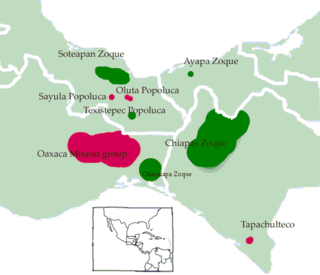
The Mixe–Zoque languages are a language family whose living members are spoken in and around the Isthmus of Tehuantepec, Mexico. The Mexican government recognizes three distinct Mixe–Zoquean languages as official: Mixe or ayook with 188,000 speakers, Zoque or o'de püt with 88,000 speakers, and the Popoluca languages of which some are Mixean and some Zoquean with 69,000 speakers. However, the internal diversity in each of these groups is great. Glottolog counts 19 different languages, whereas the current classification of Mixe–Zoquean languages by Wichmann (1995) counts 12 languages and 11 dialects. Extinct languages classified as Mixe–Zoquean include Tapachultec, formerly spoken in Tapachula, along the southeast coast of Chiapas.

The Tuxtla Statuette is a small 6.3 inch (16 cm) rounded greenstone figurine, carved to resemble a squat, bullet-shaped human with a duck-like bill and wings. Most researchers believe the statuette represents a shaman wearing a bird mask and bird cloak. It is incised with 75 glyphs of the Epi-Olmec or Isthmian script, one of the few extant examples of this very early Mesoamerican writing system.
Mesoamerica, along with Mesopotamia and China, is one of three known places in the world where writing is thought to have developed independently. Mesoamerican scripts deciphered to date are a combination of logographic and syllabic systems. They are often called hieroglyphs due to the iconic shapes of many of the glyphs, a pattern superficially similar to Egyptian hieroglyphs. Fifteen distinct writing systems have been identified in pre-Columbian Mesoamerica, many from a single inscription. The limits of archaeological dating methods make it difficult to establish which was the earliest and hence the progenitor from which the others developed. The best documented and deciphered Mesoamerican writing system, and the most widely known, is the classic Maya script. Earlier scripts with poorer and varying levels of decipherment include the Olmec hieroglyphs, the Zapotec script, and the Isthmian script, all of which date back to the 1st millennium BC. An extensive Mesoamerican literature has been conserved, partly in indigenous scripts and partly in postconquest transcriptions in the Latin script.

Cerro de las Mesas, meaning "hill of the altars" in Spanish, is an archaeological site in the Mexican state of Veracruz, in the Mixtequilla area of the Papaloapan River basin. It was a prominent regional center from 600 BCE to 900 CE, and a regional capital from 300 CE to 600 CE.

The Zoque languages form a primary branch of the Mixe–Zoquean language family indigenous to southern Mexico by the Zoque people.

Chiapa de Corzo is an archaeological site of pre-Columbian Mesoamerica located near the small town of Chiapa de Corzo, Chiapas.
Terrence Kaufman was an American linguist specializing in documentation of unwritten languages, lexicography, Mesoamerican historical linguistics and language contact phenomena. He was an emeritus professor of linguistics and anthropology at the University of Pittsburgh.

Las Limas Monument 1, also known as the Las Limas figure or the Señor de las Limas, is a 55 centimetres (22 in) greenstone figure of a youth holding a limp were-jaguar baby. Found in the State of Veracruz, Mexico, in the Olmec heartland, the statue is famous for its incised representations of Olmec supernaturals. It is the largest known greenstone sculpture.

Many undeciphered writing systems exist today; most date back several thousand years, although some more modern examples do exist. The term "writing systems" is used here loosely to refer to groups of glyphs which appear to have representational symbolic meaning, but which may include "systems" that are largely artistic in nature and are thus not examples of actual writing.

The Feathered Serpent is a prominent supernatural entity or deity found in many Mesoamerican religions. It is called Quetzalcoatl among the Aztecs; Kukulkan among the Yucatec Maya; and Q'uq'umatz and Tohil among the K'iche' Maya.

Classic Veracruz culture refers to a cultural area in the north and central areas of the present-day Mexican state of Veracruz, a culture that existed from roughly 100 to 1000 CE, or during the Classic era.
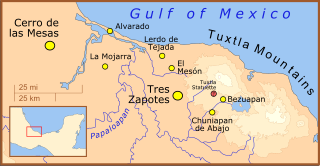
The Epi-Olmec culture was a cultural area in the central region of the present-day Mexican state of Veracruz. Concentrated in the Papaloapan River basin, a culture that existed during the Late Formative period, from roughly 300 BCE to roughly 250 CE. Epi-Olmec was a successor culture to the Olmec, hence the prefix "epi-" or "post-". Although Epi-Olmec did not attain the far-reaching achievements of that earlier culture, it did realize, with its sophisticated calendrics and writing system, a level of cultural complexity unknown to the Olmecs.
Olmec hieroglyphs are a set of glyphs developed within the Olmec culture. The Olmecs were the earliest known major Mesoamerican civilization, flourishing during the formative period in the tropical lowlands of the modern-day Mexican states of Veracruz and Tabasco. The subsequent Epi-Olmec culture, was a successor culture to the Olmec and featured the Isthmian script, which has been characterized as a full-fledged writing system, though with its partial decipherment being disputed.

Las Choapas is a recently found archaeological site located within the municipality of Las Choapas, in the southeastern border of the Veracruz State, inside the San Miguel de Allende Ejido, bordering the municipalities of Huimanguillo, Tabasco and Ostuacán, in Chiapas.
